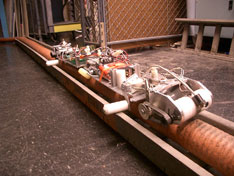Categories: Interesting Facts, Interesting electrical news, About electricians and not only
Number of views: 36094
Comments on the article: 0
Created a robot electrician for repairing overhead lines
 Everyone knows that no one is safe from the effects of storms, hurricanes, storms and other natural disasters. Therefore, it should be soberly aware that the next rainstorm with the same probability can leave without light both a small office and a huge corporation. What to do in the event of a cable break or some kind of malfunction? Call electricians? Or rent a robot that independently does all the work much faster, and possibly better. Say fiction? Of course, who will develop robots-electricians, if there are more interesting applications for these silicon creatures. And you don’t have to go far - robotic singers and bartenders, nannies and teachers, doctors, toys. And here I do not agree.
Everyone knows that no one is safe from the effects of storms, hurricanes, storms and other natural disasters. Therefore, it should be soberly aware that the next rainstorm with the same probability can leave without light both a small office and a huge corporation. What to do in the event of a cable break or some kind of malfunction? Call electricians? Or rent a robot that independently does all the work much faster, and possibly better. Say fiction? Of course, who will develop robots-electricians, if there are more interesting applications for these silicon creatures. And you don’t have to go far - robotic singers and bartenders, nannies and teachers, doctors, toys. And here I do not agree.
Scientists have created a robot that, in stand-alone mode, will be able to independently test or diagnose many kilometers of the power cable, identify problems and possibly even determine “preliminary” malfunctions, which, in the future, can cause network problems.
Professor, electronic engineer Alexander Mamishev told the press that such a development is the first in the industry. Mamishev visited New Orleans, where he conducted test launches of the robot. This city was chosen as the so-called "test" site for the Robotic Cable Inspection System (this is what the robot is called) because a year earlier New Orleans suffered massive damage due to Hurricane Katrina and floods, which caused numerous breaks and malfunctions of power lines. It turns out that a year later there were still metro sections in the city that were not completely repaired, and even unsafe for human life.
The Robotic Cable Inspection System was primarily involved in testing high-voltage lines from the power plant to the districts. In Orleans, such cables more than 6 cm thick are usually routed in subway tunnels. And if the salty sea water brought into the city along with a hurricane seeps through insulation or winding, damaged by the elements, this can cause a short circuit, which can again leave entire neighborhoods without light.
The robot determines cable information by examining its surface. There are 3 sensors for this: a thermal sensor, a sound or acoustic sensor, and a sensor developed by Mamishev that detects “water trunks”, i.e. water that managed to seep into the insulation. The thermal sensor, in turn, is looking for areas where heat dissipation is observed, and the acoustic one is “listening” for the cable in search of damaged areas. Scientists can monitor the robot through a wireless interface, as well as monitor what is happening with a small video camera.
Now a robot electrician is working on a fairly serious facility - Lockheed Martin's Michoud NASA Assembly Facility. This huge factory is developing rocket elements used by NASA. Working at such an important facility, according to the developers, will allow you to slightly promote and advertise the Robotic Cable Inspection System.
Mamishev noted that today the implementation of work for a person is a boring, lengthy and costly task. Therefore, scientists hope that soon the robots will learn to do the lion's share of the work that we either don’t like or cannot do.
See also at bgv.electricianexp.com
:

